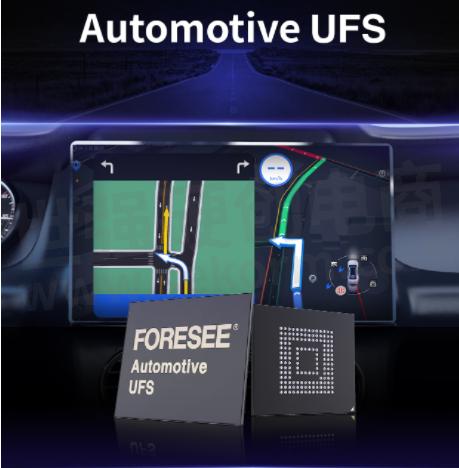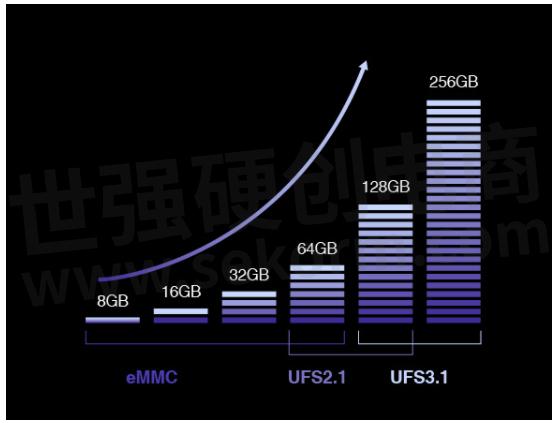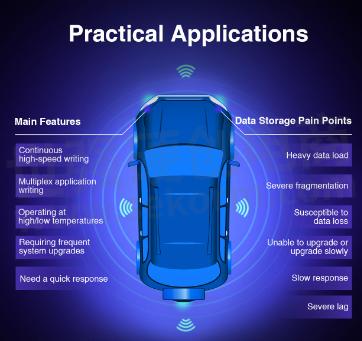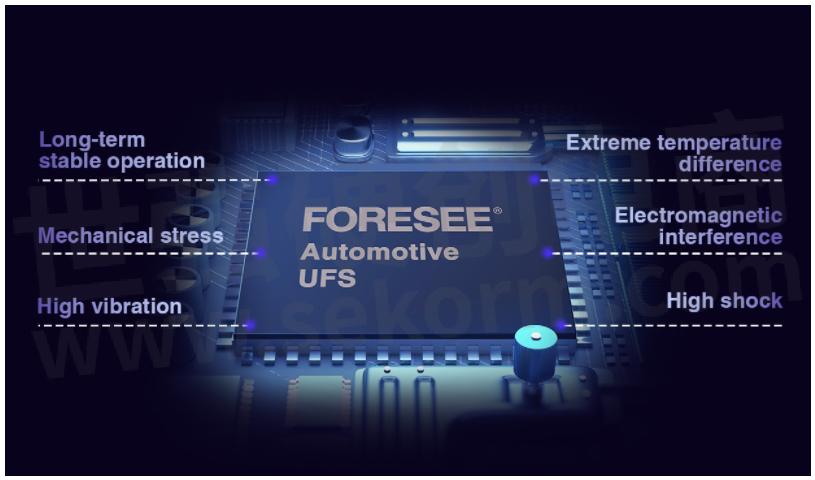Read Speed Increased Six-fold! Longsys‘s FORESEE Automotive UFS Powers Automotive Storage Upgrades

Automotive electronics architecture has evolved from the electronic control unit (ECU), gone through the domain control unit (DCU) era, and is now entering the central computing era. The high standards and strict requirements for intelligent vehicle computing power, integration, and data transmission have made storage reliability, stability, and read/write performance a key research topic for automobile manufacturers and storage vendors.
As an automotive storage vanguard, Longsys has officially launched the first Automotive UFS in the Chinese mainland, becoming the first to provide automobile manufacturers with storage products that are more suitable for advanced automotive applications.

(Automotive UFS)
Capacity:64GB/128GB
NAND Flash:3D NAND
PPM:<5PPM
Size:11.5x13.0mm
Operating Temperature:-40℃~105℃
Package: FBGA153
Voltage:VCC:2.7-3.6V;VCCQ2:1.7-1.95V
Protocol: UFS2.1,UFS3.1(Coming soon)
Interface: HS-Mode G3 2Lane
Automotive UFS: Pearls can be everywhere, but there are not always many eyes that can see them
Among the mainstream storage products currently used in intelligent vehicles, eMMC products still lead the global market share. However, they have reached their performance limit. The development of the eMMC protocol cannot bring substantial progress. It is difficult for eMMC products to be compatible with the higher requirements needed in automotive applications. "Chip reform" is essential for automotive storage. Calls for automotive UFS applications are also becoming louder.
Longsys's internal test data directly show that for data transfers, FORESEE's automotive UFS 2.1 products outperform eMMC products by 1.5x in write performance and 2.5x in read performance. UFS 3.1 products have more than 6x higher read performance and more than 4x higher write performance than eMMC products. In terms of input/output operations per second (IOPS), UFS is dozens of times faster than eMMC, which can reduce transfer latency, and improve storage speed for vehicle applications. In addition, the automotive UFS package remains the same size as the eMMC package, making it easy for automobile manufacturers to switch seamlessly between the two.
Comparison of the tested performance of UFS and eMMC:

*Data is sourced from internal testing of Longsys. The actual performance may vary between different devices.
UFS has a significant performance advantage
With the front-loading rate of various vehicle systems increasing, and smart cockpit technology becoming more popular, the demand for storage capacity has also increased from 8-16GB to 32-64GB. In the long run, advanced vehicle systems and highly integrated vehicle terminals will proliferate. It is foreseeable that 128-256GB storage products will become paramount in the near future. Conforming to the trend, FORESEE has launched automotive UFS products with 64GB and 128GB capacity options to satisfy current and future needs.

(Rising demand for automotive storage capacity)
There is a big gap between practical automotive UFS and eMMC applications
Intelligent vehicle applications can be briefly categorized into intelligent vehicle networks, intelligent cockpit systems, and driver assistance systems. Storage devices are widely used in automobile components such as center console navigation, infotainment, event data recorders, advanced driver-assistance systems (ADAS), digital dashboards, T-boxes, dashboard cameras, etc.
Automotive Storage Applications
ADAS
ICS
EDR
IVI
DVR
Dashboard
AVM
T-BOX
(Automotive UFS is widely used in intelligent vehicle terminals)
For example, ADAS applications require the real-time collection of a large volume of information on the complex road conditions and the environment surrounding a moving vehicle. As ADAS evolve (especially to driving automation level 2/3 or higher), the number of sensors and cameras installed in a vehicle increases, and the amount of data collected proliferates. The collected data then needs to be transmitted, stored, identified, and analyzed to assist in decision-making.
Under such circumstances, the requirement for advances in continuous and multiplexed read/write performance for storage devices has risen significantly in ADAS applications. However, automotive eMMC cannot outperform UFS in either of these two key areas. In early ADAS upgrades and iterations when eMMC was used in automotive storage, ADAS might suffer from increased latency and poor application responsiveness, which directly affected the driving experience and would even endanger driver safety. Therefore, FORESEE's automotive UFS products that can read and write more rapidly are bound to become a forward-looking move for automobile manufacturers.
Practical Application

AEC-Q100, the "safe ride code" for storage
AEC-Q100 is one of the basic qualification standards for automotive storage chips. This standard has undergone several iterations and updates. Currently, a reliability qualification standard containing 7 major items and 41 minor items has been formed. These AEC-Q100 qualification items cover almost all of the reliability challenges faced by automotive storage. In other words, being AEC-Q100 qualified is equivalent to gaining a "ticket" into an automotive plant.

(Major AEC-Q100 test items)
FORESEE's automotive UFS products adopt manufacturers' automotive resources and high-quality components along with Longsys's in-house firmware algorithms. In addition, the automotive UFS products have all undergone rigorous reliability standard qualification tests to ensure their long-term, stable, and reliable operation in the temperature range between -40℃ and 105℃ while ensuring data security.

(Automotive storage reliability test standard qualification)
The next step for FORESEE's automotive UFS products
FORESEE's automotive UFS 2.1 products currently meet customers' basic needs to iterate from eMMC to UFS storage. 128GB and 256GB UFS 3.1 products, which feature breakthroughs in read-and-write performance and reduced power consumption and latency, will also be continually launched. These advancements will facilitate the steady growth of the intelligent automotive storage industry.
- +1 Like
- Add to Favorites
Recommend
- Embedded MultiMediaCards (eMMCs) vs. Secure Digital (SD) Cards
- Automotive Chip Provider NOVOSENSE Has Officially Become a Member of Automotive Electronics Council
- NOVOSENSE Unveiled Several Groundbreaking Automotive Chip Aiming at Automotive Applications
- MindMotion‘s First Automotive MCU MM32A0144 Has Passed AEC-Q100 Automotive Certification
- YXC Passive Automotive Grade Resonator, 50MHz, Package Size 2016, Total Frequency Difference ±80PPM, Suitable for Automotive Encoders
- Feasycom Provides Automotive Bluetooth and Wi-Fi Modules Particularly Suitable for Automotive Central Control
- Automotive-grade MCU BAT32A237 from Cmsemicon Wins the 2023 Automotive Chip Top 50 Award
- Hosiden Developed Automotive Ultracompact Coaxial Connector with Wide-band, High EMC Performance for Automotive Use
This document is provided by Sekorm Platform for VIP exclusive service. The copyright is owned by Sekorm. Without authorization, any medias, websites or individual are not allowed to reprint. When authorizing the reprint, the link of www.sekorm.com must be indicated.





























































































































































































































































































































































































































































































































































































































































































































































































































































































